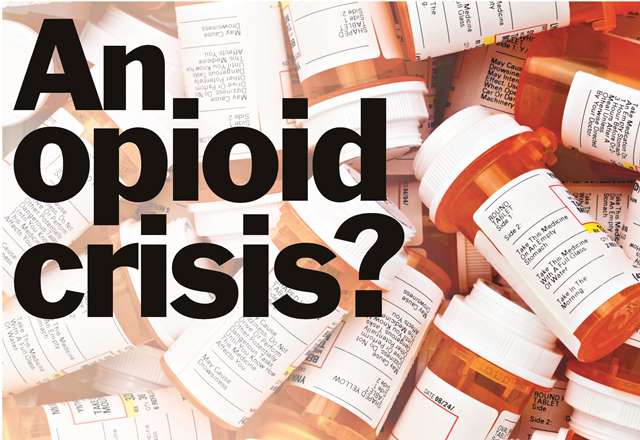One in every eight deaths among young adults is related to #opioid overdose
The misuse and abuse of opioids — strong painkillers such as morphine, codeine and oxycodone – is an issue that has grown considerably across North America over the past two decades. An American study estimated that early deaths due to #opioid abuse has resulted in more than $18 billion in lost future earnings in the United States alone.
Globally, Canada is second only to the United States when it comes to the total amount of opioids dispensed per capita.
This rise in opioid use has been attributed to a variety of factors — including their wide availability, lack of tools and training for physicians for the treatment of pain, and the belief that they are safe to use because they are prescribed by doctors.
MORE: THE WAR AGAINST SUPERBUGS
The misconception around the safety of opioids has also likely driven increased recreational use of these opioids and the sharing of these medications with friends and family.
“Opioids are over-prescribed in North America,” says Tara Gomes, a scientist at the Li Ka Shing Knowledge Institute of St. Michael’s Hospital. “They have the same active chemical in them as heroin and should not be prescribed lightly. Although there is evidence that these drugs are effective for short-term treatment of moderate to severe pain, they are increasingly being used for long periods of time at doses that have proven to be potentially dangerous.”
The “inappropriate” use of opioids is itself a difficult concept to pin down. Researchers don’t have data on how people use these drugs (e.g. if they crush/inhale/inject). They also don’t know to what extent people receiving prescriptions for these drugs are misusing or abusing them. However there is evidence clearly showing that high-dose prescribing – which can be dangerous regardless of whether or not the person is using the drugs ‘as prescribed’ – is very prevalent.
MORE: ACETAMINOPHEN – WHAT YOU NEED TO KNOW
Clinical practice guidelines recommend dosages not exceed the equivalent of 200 mg of morphine. By looking at high dose prescribing, Gomes found that more than one-quarter of the patients eligible for Ontario Drug Benefit Program who were treated with long-acting opioids received doses that exceed the recommended guidelines. More than one-third of those getting long-acting oxycodone, such as #OxyContin, also received higher-than-recommended doses.
It’s hard to know exactly on how often opioids are prescribed because data is limited, but research shows that six years ago nearly 1.5 million opioid prescriptions were given to the 180,000 Ontarians between the ages of 18 and 64 who were eligible for the Ontario Drug Benefit Program.
Today that number likely exceeds 1.5 million prescriptions.
Gomes recently showed the impact of Ontario’s high prevalence of opioid use on overdose deaths. Her study showed that rates of overdose deaths increased nearly 250 per cent over the past two decades. This research, published in the journal Addiction in July, also revealed that these deaths are increasingly impacting Ontario’s young adults. One in every 170 deaths among Ontarians is related to opioid overdose; that number climbs to one in every eight deaths among young adults.
Opioid overdoses can occur when someone accidentally misuses a prescribed opioid or when opioids are intentionally tampered with to achieve a ‘high’. This tampering may include chewing, crushing and inhaling, or dissolving and injecting opioids.
Pharmaceutical companies have worked to develop safer formulations of opioids since concerns were raised about the safety of opioids – particularly when used inappropriately. One such example is the replacement of OxyContin in 2012 with a new tamper-deterrent formulation of long-acting oxycodone called OxyNeo.
Despite such advances, there is concern that pharma’s approach may not adequately address the issue of opioid abuse in North America.
“Although the intent of tamper-deterrent formulations of opioids is to make them more difficult to crush, inhale or inject, the effectiveness of these changes have not been proven in the real-world, says Gomes. “Drug abusers have proven themselves very creative at finding ways to get high.”
Furthermore, tamper-deterrent forms of opioids haven’t done much to curb overall rates of opioid abuse because a large number of original, non-tamper-deterrent opioids are still available on the market.
“To combat this epidemic, we need to make sure that opioids are being used in a safe and effective manner and this starts with prescribers,” says Gomes. “Unfortunately, our health care system is not designed to provide them with sufficient information upon which to base these decisions. If a prescriber can’t confirm whether a patient is receiving prescriptions for opioids from multiple sources, they are often unable to determine whether a patient needs these drugs for legitimate pain, or if they are sourcing large quantities of opioids because they are addicted to opioids or are selling them illegally for profit.”
This is particularly difficult for physicians treating patients in an emergency department. Unlike a family practice, where the doctors and nurses have a history with their patients and can more readily identify indicators of opioid addiction, emergency department clinicians are often seeing patients for the first time and without the hindsight of recent visits.
It can be difficult for them to discern the difference between someone with legitimate severe pain who may benefit from an opioid and someone with an opioid addiction.
“In an emergency department, clinicians often have limited time and information to determine whether a patient’s pain is legitimate and how it should best be treated,” said Gomes. “Electronic health records that are accessible to prescribers throughout the healthcare system would provide clinicians with enough information to determine a patient’s medication history, and whether they may be exhibiting drug–seeking behavior. Identifying patients who might be addicted to, or diverting these potentially dangerous medications would help reduce the prevalence of opioid overdoses and related deaths in Ontario.”




